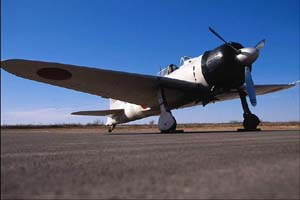Mitsubishi A6M2
Model 21
Rei-sen (Zero)
Japanese Carrier Fighter
 |
The Ghost Squadron's Zero.
. Image source: The Confederate Air Force Ghost Squadron CD-ROM produced by Corel. Photos by Bill Crump. |
When the appearance of a new Japanese fighter with retractable landing gear and phenomenal speed and agility was reported by the few western observers in China in 1940, most military experts in the U.S. scorned the reports as propaganda.
On 7 December, 1941 and in the weeks and months that followed, however, the Mitsubishi A6M2 Type 0 Model 21 carrier fighter, called Rei-sen or "Zero fighter" by the Japanese and "Zero" or its code name "Zeke" by the Allies, proved to be not only real, but a deadly foe in aerial combat.
After initial combats, several weaknesses were found in the Zero’s design, including a complete lack of armor protection for the pilot, lack of self-sealing fuel tanks and a generally light construction, and Allied pilots quickly developed new tactics to exploit these weaknesses.
The CAF’s Zero is a Nakajima-built A6M2 Model 21, of the same type that participated in the attack on Pearl Harbor and the carrier battles of 1942.
It carries serial number 5356 indicating that it was produced on or about 10 October, 1942 and was assigned to the 5th Carrier Division on the IJN Zuikaku, one of Japan’s largest carriers. The Zuikaku air group participated in combat at Rabaul, Guadalcanal, Oro Bay, Port Moresby, Rabi and elsewhere until late 1943. Sometime in 1944, some of the Zuikaku’s planes were left on islands in the Solomons Group, probably including our Zero.
The aircraft were lost or forgotten until rediscovered in 1968, on the small island of Balalai (spellings vary) by a Canadian, Robert Deimert, who managed to recover the partial remains of several Japanese aircraft, including three Zeros and an Aichi D3A Val dive bomber.
The CAF purchased the partially restored Zero from Mr. Deimert, and in 12 August, 1985, it made its first flight in over forty years, powered by an American Pratt & Whitney R-1830 engine of similar power and size.
In 1989, the Zero was assigned to Col. John Kelley and based at the Dallas/Fort Worth Wing’s facility in Lancaster, Texas, just south of Dallas, where the restoration was completed by a dedicated band of CAF volunteers. After several years of air shows, the Zero was assigned to sponsor Col. David Price, in Santa Monica, California and spends half the year there and half at CAF HQ in Midland, Texas.
Of the more than 10,000 Zeros produced by the Japanese in World War II, this is one of only two or three still regularly flying in the world.
Note: The CAF A6M2 Zero is currently not airworthy, needing major work on its wing structure. It is located at the Southern California Wing's facilities in Camarillo, Calif.
Specifications
One Pilot One Nakajima NK1C Sakai 12 Engine Two 37 mm Cannons Max. Speed 332 mph @ 15,000 feet Climb to 20,000 ft in 7.5 minutes |
Length 32' 8" Max. Weight 6,164 lbs Normal Fuel 141 gallons Normal Range 1,160 miles |